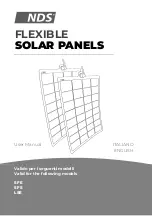
P a g e
|
8
•
Wiring on the roof…
The installer must be trained in, and will be responsible for, the parallel pluggable
touch-safe AC or DC connections between the solar module assemblies.
•
Use proper wire management techniques...
Ensure that none of the AC or DC wires are pinched or
damaged during installation. Secure all loose cables with wire ties to the DecoTech™ Module Assembly.
•
Do not modify factory-applied connectors, terminals, or jumper cables…
Do not customize or modify the
provided DC or AC cables or connectors in the field.
•
Do not repair…
The solar module assembly does not contain any user-serviceable parts. If the product
fails, it should be replaced by contacting GAF. Tampering with the DecoTech™ Module Assembly will void
the warranty of the product.
•
Thermal & voltage hazard…
Certain parts of the DecoTech™ Module Assembly may be extremely hot due
to the continued exposure to the sun. This unit should be installed in a location where it is protected
against casual contact. Certain parts may also be extremely hot and represent an electrical hazard while
servicing the system immediately following shutdown.
•
Follow codes…
Perform all electrical installations in accordance with any local codes and the NEC
(National Electrical Code) ANSI/NFPA 70 for U.S. installations.
•
Re-inspection…
Regularly re-inspect the solar system to ensure that all fasteners are securely tightened
and corrosion-free; that wiring is securely connected and free of corrosion; and that cables are free of
damage. This is important especially after storms and in areas prone to hail and high winds. If any damage
is found, the DecoTech™ Module Assembly should be replaced immediately.
•
Be aware of ground faults…
Grounded conductors may become ungrounded and energized when a
ground fault is indicated, resulting in risk of electric shock. Prior to touching any part of the product, use
care to ensure surfaces and equipment are at touch-safe temperatures and voltage potentials (by testing
with a multimeter) before proceeding. Anytime the AC microinverter or DC optimizer has been
disconnected from the power network, use extreme caution as some components can retain a charge
sufficient enough to create a shock hazard.
•
Licensed electrician…
Installing AC or DC combined circuits, switches, tie-in to the PV point of connection,
OCPDs, and initial startup of the PV system
must
be performed by a licensed electrician. Make all electrical
connections (e.g., conductor termination, fuses, potential earth connection, etc.) in accordance with the
electrical standards prescribed by the applicable NEC wiring methods and/or by other local regulations
and codes.









































